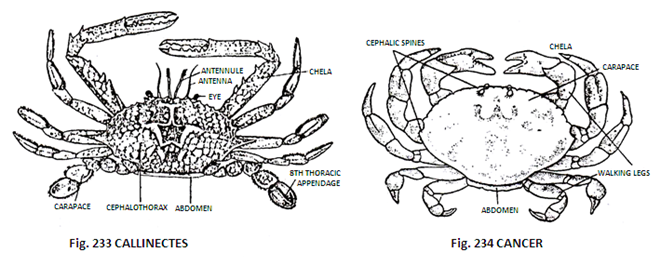In this article we will discuss about the structure of crabs with the help of suitable diagrams.
 1. These are commonly known as “crabs” and are found buried under rocks, wood pieces and in sand along sea shore.
1. These are commonly known as “crabs” and are found buried under rocks, wood pieces and in sand along sea shore.
2. Body is flat and covered by a carapace. It is comprised of a cephalothorax of 13 segments and abdomen is curved below the cephalothorax.
3. The cephalothorax is comprised of 13 (5 + 8) segments of cephalic and thoracic region, is much broader then its length and is covered over by a carapace.
4. Carapace in callinectes is beautifully decorated and is produced into a pair of spines laterally.
5. The cephalothorax bears a pair of stalked compound eyes, a pair each of small antennule and antennae.
6. Mouth parts and first two maxillepedes are exceedingly small and are covered over by third maxillepede which acts as operculum or cover.
7. Of the five pairs of walking legs, first pair is chelate and is largest. The second to fifth pairs are non-chelate and sufficiently developed and clawed.
8. Abdomen is reduced, flattened, movably articulated and is curved or flaxed permanently in a groove below cephalothorax. It is comprised of six segments and a telson. Abdominal appendages are degerate.
9. In male, however, two pairs of pleopods are present modified into copulatory organs, whereas, in females four pairs are present and are modified for carrying eggs. The uropods being completely absent.
10. Sexes are separate and development is indirect.
Note:
The front margins of carneace are comparatively smooth in Cancer and senated in Callinectes and are having few sockets for eyes, antennule and antennae.